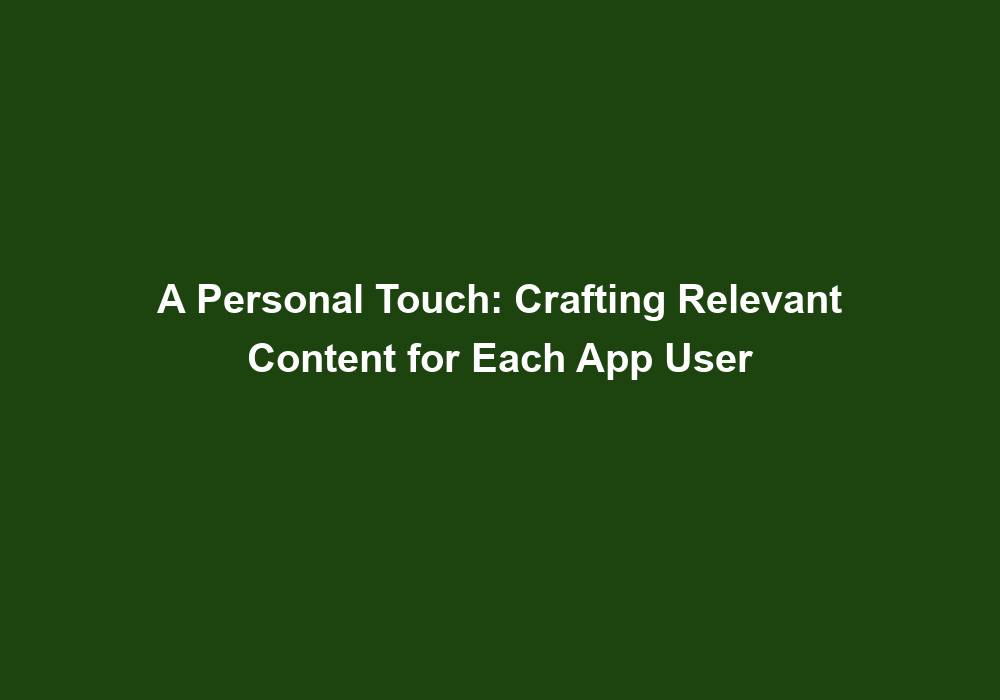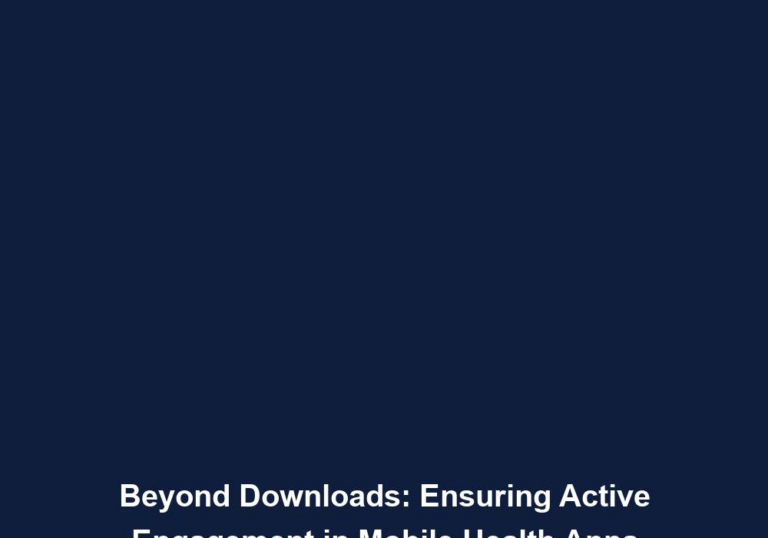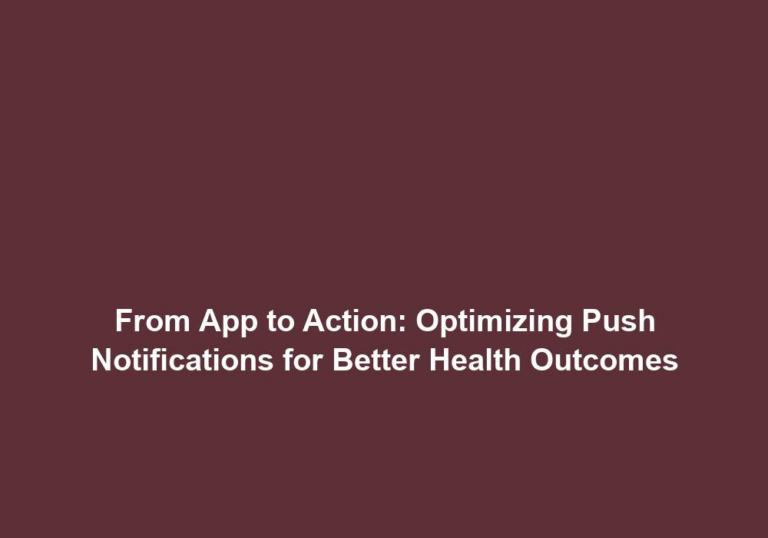A Personal Touch: Crafting Relevant Content for Each App User
In today’s digital age, personalized experiences have become the norm. From tailored recommendations on e-commerce platforms to personalized news feeds on social media, users expect content that caters to their individual needs and preferences. This is especially true in the realm of mobile apps, where delivering a personalized experience can significantly enhance user engagement and satisfaction.
To achieve this, app developers and marketers must focus on crafting relevant content for each app user. By understanding their audience and implementing effective strategies, they can create a personalized experience that keeps users coming back for more.
Understanding Your Audience
Before diving into the specifics of crafting personalized content, it is crucial to understand your audience. Conduct thorough market research and gather data about your user base. This data may include demographics, interests, preferences, and behavioral patterns.
Analyzing this information will help you identify commonalities and trends among your users. For example, you may discover that a significant portion of your user base consists of young adults interested in fitness and wellness. Armed with this knowledge, you can tailor your content and messaging to appeal specifically to this demographic.
Additionally, understanding your audience allows you to identify pain points and challenges they may be facing. By addressing these issues through your content, you can position your app as a valuable solution, further enhancing user engagement and satisfaction.
Utilizing User Segmentation
One effective strategy for crafting relevant content is user segmentation. By dividing your user base into distinct segments based on specific criteria, you can create personalized experiences for each group. Some common segmentation factors include:
-
Demographics: Age, gender, location, and language can significantly impact user preferences and interests. For example, a language learning app may segment users based on their preferred language to provide content tailored to their language learning goals.
-
Behavior: Analyzing user behavior, such as frequency of app usage, purchase history, and interaction patterns, can help identify personalized content opportunities. For instance, an e-commerce app may segment users based on their past purchase history to recommend similar products or offer exclusive discounts.
-
Interests: Understanding your users’ hobbies, preferences, and areas of interest allows you to curate content that aligns with their passions. For example, a cooking app may segment users based on their cooking preferences (e.g., vegan, gluten-free) to provide recipes and tips that cater to their dietary needs.
By segmenting your audience and tailoring your content accordingly, you can ensure that each user receives a personalized experience that resonates with their unique needs and interests.
Dynamic Content Customization
To provide a truly personalized experience, consider implementing dynamic content customization. This approach involves dynamically adjusting the content displayed to users based on their actions, preferences, or previous interactions with the app.
Here are some examples of dynamic content customization techniques:
-
Personalized Recommendations: By analyzing user behavior and preferences, you can offer personalized product or content recommendations. This can be based on past purchases, browsing history, or similar users’ preferences. For instance, a streaming app may recommend movies or TV shows based on a user’s previously watched content or genre preferences.
-
Location-Based Content: Leveraging GPS or IP-based location tracking, you can provide users with location-specific content, such as nearby events, offers, or recommendations. For example, a travel app may offer personalized recommendations for attractions or restaurants based on the user’s current location.
-
Behavioral Triggers: Set up triggers that automatically display specific content or offers based on user actions or milestones. For example, sending a personalized celebratory message when a user reaches a certain level in a game or completes a goal. This not only enhances the user’s experience but also encourages further engagement with the app.
By implementing dynamic content customization, you can create a highly personalized experience that adapts to each user’s preferences in real-time.
Leveraging User-Generated Content
Another powerful way to craft relevant content for each app user is by leveraging user-generated content (UGC). UGC refers to any content created by your app’s users, such as reviews, ratings, comments, or user-generated media.
Integrating UGC into your app not only adds authenticity but also provides a personalized touch. Users often trust their peers’ opinions more than traditional advertising, making UGC an invaluable resource for content creation.
Consider incorporating the following methods to leverage UGC:
-
Encourage Reviews and Ratings: Prompt users to leave reviews and ratings for your app or its features. Showcase positive reviews and highlight user success stories to inspire others. This social proof can significantly influence potential users’ perception of your app.
-
Social Media Integration: Enable users to share their experiences and achievements on social media platforms directly from your app. This not only increases engagement but also generates UGC that can be repurposed for marketing purposes. For example, a fitness app may allow users to share their workout progress on Instagram, inspiring others to join their fitness journey.
-
User-Generated Contests/Challenges: Organize contests or challenges that encourage users to create and share content related to your app. For example, asking users to submit photos or videos of them using your app in creative ways. This not only generates UGC but also fosters a sense of community among your users.
By leveraging UGC, you can tap into the power of user-driven content creation, enhancing the personalized experience for each app user.
Measuring Success and Iterating
Crafting relevant content is an ongoing process that requires constant evaluation and iteration. To ensure the effectiveness of your personalized content strategy, track relevant metrics and measure success.
Some key metrics to consider include:
-
User Engagement: Monitor metrics such as session duration, frequency of visits, and interactions with personalized content to gauge user engagement. A higher engagement indicates that users find your content relevant and valuable.
-
Conversion Rates: Measure the effectiveness of personalized content in driving desired actions, such as sign-ups, purchases, or app downloads. A higher conversion rate indicates that your content is compelling and persuasive.
-
User Feedback: Solicit feedback from your users through surveys or app store reviews to understand their perception of the personalized content. Use this feedback to iterate and improve your content strategy. User feedback provides valuable insights into what is working and what can be enhanced.
By continuously analyzing and iterating based on data-driven insights, you can refine your content strategy and ensure that it remains relevant and impactful for each app user.
Conclusion
Crafting relevant content for each app user is essential to create a personalized experience that resonates with your audience. By understanding your users, utilizing segmentation, implementing dynamic content customization, leveraging UGC, and measuring success, you can deliver a personalized experience that keeps users engaged, satisfied, and coming back for more. Remember, the key lies in understanding your audience and tailoring your content to meet their unique needs and preferences.





